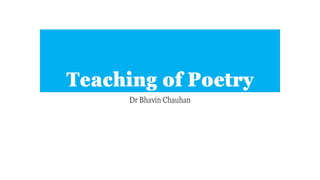
Teaching of Poetry
- 1. Teaching of Poetry Dr Bhavin Chauhan
- 2. Poetry: Nature and Concept • Poetry has tremendous appeal for children, and it is the best way of exciting their love of the language. • It lays the foundation for the appreciation of the beauty of language. • It educates their emotions and enhances their power of imagination. • The rhythm of poetry helps the students to acquire natural speech rhythm
- 3. Poetry: Nature and Concept Poetry leads an all-round development of the whole personality of the pupils particularly the emotional, imaginative, intellectual aesthetic and intuitive sides. • Prof. S. Subrahamanyam
- 4. Poetry: Reasons to Teach • Memorizing and reciting poetry build confidence. • Poems give children an easy way to remember a lesson or value. • Poem inspire us. • Poem capture emotions and ideas in lyrical phrases that are often easy to remember. Poem offer a chance to build connections within multiple areas of child’s curriculum. • You can use poetry to teach grammar and vocabulary.
- 5. Objectives of Teaching Poetry • Poetry is taught for sheer pleasure and enjoyment. It further lays the foundation for an adequate appreciation of English poetry. Therefore, the aims of teaching of poetry should be different for different levels. General Aims At Primary Level (i) To enable the students to recite the poem with proper rhythm and intonation. (ii) To enable the students to enjoy the recitation of the poem. (iii) To develop the students' power of imagination. (iv) To train the emotions of the students. (v) To develop love for poetry reading and writing.
- 6. Objectives of Teaching Poetry At Secondary /Higher Secondary Level (i) To enable the students to appreciate the poem. (ii) To enable them to understand the thought and imagination contained in the poem. (iii) To appreciate the rhyme & rhythm and style of the poem. (iv) To train the emotions, feelings and imagination of the students. (v) To develop their aesthetic sense. (vi) To create love for English poetry.
- 7. Objectives of Teaching Poetry Specific Aims The specific aims of teaching poetry differ from poem to poem. They depend largely on situation, scene, feeling and thought depicted in the poem. (i) To enable the students to recite the poem namely '-----------------' with proper rhyme and rhythm. (ii) To enable the students to enjoy the recitation of the poem '-------------' (iii) To understand the central idea of the poem. (iv) To communicate the exclusive message of the poem to the students. (v) To enable them to appreciate the beauty and images depicted in the poem.
- 8. Steps of Teaching Poetry 1. Read the Poem Aloud. Have students listen to you as you read the poem aloud. If it is difficult poem, you may want to give them some background information before you begin. 2. Identify and Define Words the Students do not Know. Ask the students for words that they are unfamiliar with. Then, have the students write each word’s definition on their sheet. You can either have a student look up the words in a dictionary, or you can have the definitions prepared ahead of time.
- 9. Steps of Teaching Poetry 3. Read the Poem Aloud Again. Listening to a poem a second time will help students to understand it. Before you do this, you may want to ask students to listen for something in particular. You might ask, “How does the author of this poem feel about flowers?” “How do you know?” “What is your opinion on selecting red rose by the poet?”
- 10. Steps of Teaching Poetry 4. Summarize the Poem Students are asked to summarize the poem in his/her own words. This can be very helpful when you are teaching more complicated poems to older students. This can be done with younger students also. It is important to know that they understand the general idea of the poem. It helps if you come to class with a prepared summary that the students can copy.
- 11. Steps of Teaching Poetry 5. Discuss the Poem. This is the time to ask them key questions about the poem and the characters in it. You may ask them to choose one word to describe the main character in the poem. I like asking students to support their answers using language or information form the poem. For instance, if they say that the main character is bossy, they should be able to give examples from the poem of the main character actually being bossy.
- 12. Steps of Teaching Poetry 6. Ask Student for their Experiences. Ask students to relate the poem to their lives. You might say, “ Describe an experience that you have had when you felt as carefree as the poet.” This is also a good time to make connections with other parts of the child’s curriculum. You may say, “Does this poem remind you of any of the literature characters whom we have read about?”
- 13. Steps of Teaching Poetry 7. Memorize the Poem • If you are teaching a long poem, break in into smaller chunk and assign a doable sections for students to memorize.
- 14. Steps of Teaching Poetry 8. Recite the Poem. You may want to have students recite the poem in front of the class, or possibly at a recital where you invite parents or other students.
